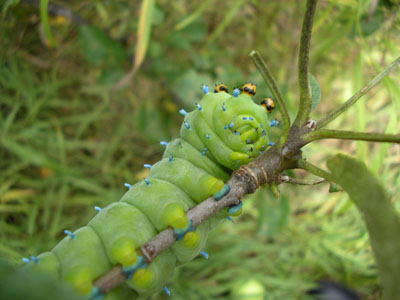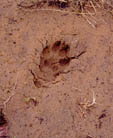Ringmaster Steve of Sunbeams from Cucumbers (now there's an idea) has put together a great show. Check it out!

Watch for Circus of the Spineless #13, September 30, at Deep Sea News.
Thomasburg is a small hamlet in the Municipality of Tweed in eastern Ontario. Behind my home here is a fallow field, swamp, cedar bush, old apple orchard and woods. Almost every day I take the same walk through this territory to see who's been by, and try to figure out what they've been up to.

 It had a few apples on it--I took some, left a couple, and cut the well-laden grapevine off it. I'll go back and clear the grapevine further back, and maybe next year this tree will produce a real crop. It's great to have all these wild grapes, but the vines kill trees, so I try to take them off of any trees that I want to protect. The grapevines are winning (maybe because there's too much edge and not enough woods) so I don't have any compunction about taking the side of the trees.
It had a few apples on it--I took some, left a couple, and cut the well-laden grapevine off it. I'll go back and clear the grapevine further back, and maybe next year this tree will produce a real crop. It's great to have all these wild grapes, but the vines kill trees, so I try to take them off of any trees that I want to protect. The grapevines are winning (maybe because there's too much edge and not enough woods) so I don't have any compunction about taking the side of the trees.
To make the juice: rinse the fruit clusters, cover with water, bring to a boil, boil gently for about 10 minutes, crush through a sieve, strain though a jelly bag, or three or four layers of cheesecloth in a colander. (Get a jelly bag!) I cooked up the sumac with a few apples because I intended to use both in the jelly anyway, and to check the cooking time (until the apples are soft). I was nervous about both how it looked and how it smelled, but I went ahead. The juice will keep in the refrigerator for a few days.
Make your apple juice the same way--for small apples, cut off the blossom and stem end before cooking; larger ones, cut in quarters.
Apple-Sumac Jelly
7 cups juice:
3.5 cups sumac juice
2.5 cups apple juice
1 cup commercial apple-cranberry juice (which had been sitting in the fridge), added to make up the 7 cups.
The proportion of apple to sumac juice was arrived at by the amount of each I had ready. The commerical juice was a whim I had. Different proportions and different bits of whimsy would probably work out as well.
In a large pot, stir in one packet of pectin crystals, bring to a boil, add 8 cups sugar and boil hard for one minute. Take off heat, skim, bottle and seal, according to whatever system you use for this.
 The jelly is delicious! Mine is a little soft, either because of the commercial juice I added or because it boiled over (use a large enough pot!!), so might not have boiled hard for the full minute. But I like it soft, so am content. Jelly depends partly on the pectin content of the fruit you start out with, something best determined by how the jelly turns out.
The jelly is delicious! Mine is a little soft, either because of the commercial juice I added or because it boiled over (use a large enough pot!!), so might not have boiled hard for the full minute. But I like it soft, so am content. Jelly depends partly on the pectin content of the fruit you start out with, something best determined by how the jelly turns out.




 There was a least one wren left in the nest when I finally left (late, but who could blame me?). Later it was reported to me that after an hour everyone had gone. So there were at least five (a normal clutch size), proving that a watering can is a good nest site for House Wrens.
There was a least one wren left in the nest when I finally left (late, but who could blame me?). Later it was reported to me that after an hour everyone had gone. So there were at least five (a normal clutch size), proving that a watering can is a good nest site for House Wrens.








 After the House Wren (Troglodytes aedon) pair successfully raised their first brood there was considerable back and forth between a perfectly good, unused nest box attached to the shed and a watering can hanging from a hook in the rafters of the patio roof. This went on for weeks, both cavities were filled with sticks, much singing was done in the vicinity of both, wrens went in and out of both. It wasn't until just last week that I saw a wren carrying food go into the watering can that I knew it was actually being used. Now it's audibly full of large nestlings that I expect will fledge very soon.
After the House Wren (Troglodytes aedon) pair successfully raised their first brood there was considerable back and forth between a perfectly good, unused nest box attached to the shed and a watering can hanging from a hook in the rafters of the patio roof. This went on for weeks, both cavities were filled with sticks, much singing was done in the vicinity of both, wrens went in and out of both. It wasn't until just last week that I saw a wren carrying food go into the watering can that I knew it was actually being used. Now it's audibly full of large nestlings that I expect will fledge very soon.
Other interesting nesting sites of the house wren have been in a fish creel or watering pot hung on the side of a shed or fence, rusty tin cans in garbage piles, old threshing machines and other farm machinery, in tin cans, teapots, and flowerpots left on shelves of sheds, in a soap dish, in old boots and shoes, and even in a bag of feathers. Outdoors they have been known to nest in the nozzle or main part of pumps, in the hat or pockets of a scarecrow, in an iron pipe railing, in a weather vane, in holes in a brick wall or building, and in a coat hung up at a camp site. One pair of wrens built their nest on the rear axle of an automobile which was used daily. When the car was driven the wrens went along. Even under these most unusual circumstances the eggs were successfully hatched (Northcutt, 1937).
 being perfected and the female was sitting on eggs. All the sounds were wren-like, but very complex at times. Even a few days ago, when feeding and poo-removal (pictured at the right) was going strong, I'd hear one or another of the wrens in the nearby spruce producing a catbird-like cacophony of squeaks and chatters.
being perfected and the female was sitting on eggs. All the sounds were wren-like, but very complex at times. Even a few days ago, when feeding and poo-removal (pictured at the right) was going strong, I'd hear one or another of the wrens in the nearby spruce producing a catbird-like cacophony of squeaks and chatters.




